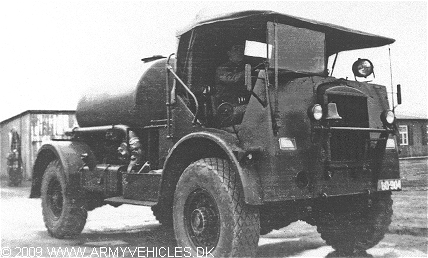Danish Army
Specific: Few vehicles
(probably around 10) delivered for use as crash tender by
the Army Air Corps.
Historical: In 1935 a new War Office
specification was issued for a medium 3 ton 4 x 4 truck
to replace the 6 x 4 IGL type and in 1938 an order for a
prototype was placed. This vehicle was of an advanced
design with independent suspension, the new 38/110 bus
engine and a 5 speed gearbox. It performed well but in
the end because of pressures to get production underway
and ease of repair the War Office requested a simpler
vehicle.
The final design, known as the FWD or Four Wheel Drive,
had an 11 foot wheelbase and used a conventional
suspension, the drive train of the 2 axle IGL and the
proven 30/70 engine. The name often used for these, the
Quad or "Q" type, is not strictly correct as
"Q" was the specification title used by the War
Office and so could be applied to vehicles from several
manufacturers of differing designs.
Just after the outbreak of war in 1939 production of the
FWD started in earnest with initial orders for 506 trucks
and 228 crash tenders, and a further 700 vehicles after
the British Expeditionary Force lost most of its
equipment in the 1940 retreat to Dunkirk. First
deliveries took place in July 1940 and nearly 800 were
delivered by the end of the year along with 340 IGL's.
In 1943 a tractor variant entered production and a more
powerful 96 bhp (later 100 bhp) engine, the 30/100,
available as an option. Three variants in all were
produced known as Types 1, 2 and 3 with differences in
transmissions and engines.
Between 1939 and 1945 7406 trucks and 2836 tractors left
the factory, deliveries peaking at 200 a month. The cabs
were mainly built by Crossley but Mulliners produced more
than 2800. Bodies were built by many makers including
Park Royal and English Electric and included wireless
vehicles, breakdown trucks, mobile cranes, crash tenders,
mobile generators and command posts. They were famously
used with a "Queen Mary" trailer by the RAF for
aircraft transport and recovery. The FWD was Crossley
Motors largest ever production run exceeding even the
World War 1 RFC, given the conditions and the cramped
factories a remarkable performance.
Length: N/A.
Width: N/A.
Height: N/A.
Weight: N/A.
Engine: Own 4-cylinder, 5.266 cm3 (321 cubic inches)
displacement, liquid cooled.
Horsepower: 90 at 2.500 rpm.
Transmission: 4-speed.
Transfer case: 2-speed.
Electrical system: 12 volt.
Brakes: Hydraulic with servo assistance.
Tyres: 10.50 - 20.
Fuel type: Petrol.
Fuel capacity: 123 liters (27 gallons).
Range: N/A.
Crew: N/A.
Additional: The vehicle carried 1350
liters (300 gallons) of water and 110 liters (25 gallons)
of foam-liquid.
|
